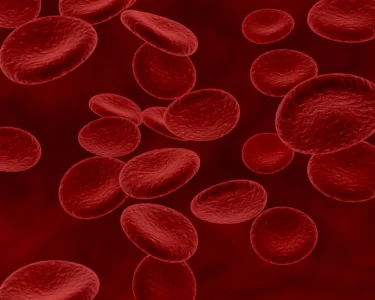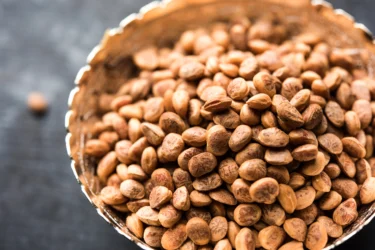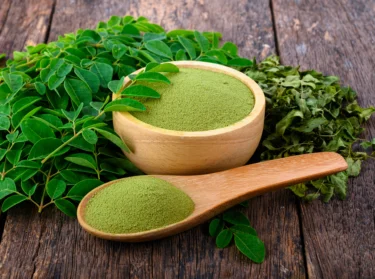Most people know Chironji as an ingredient used for dressing the various sweet dishes cooked in their kitchen on special occasions. As it replaces the almonds, it is also called ‘cuddapah almond’. It is also known as chironji tree, almondette, calumpong nut, cheronjee or hamilton mombin.
The fruit of the chironji tree bears a single edible seed, which is known as Chironji. The tree has leathery leaves with a blunt tip and rounded base, often identified by its crocodile bark with a red blaze1.
It is a wild plant growing in the forests of north, central, and western India, mainly in the states of Rajasthan, Gujarat, Madhya Pradesh, Bihar, Orissa, Jharkhand, Chhattisgarh, Andhra Pradesh and Maharashtra. Almost all the parts of the tree are used in some or the other forms. Fruits are eaten raw they taste a bit like sweet grapes2.
Did you know?
Chironji tastes pleasant, slightly acidic, and almost comparable to almonds3. Chironji is a valuable source of protein and fat with a relatively lower calories count4. Below is the nutritional content in chironji (per single unit of the kernel)4:
Various parts of the chironji tree may have properties such as:
In my practice, I have observed that it is worth considering the use of the methanolic extract of chironji leaves as a potential therapeutic agent for inflammatory conditions. The extract has shown significant anti-inflammatory activity, comparable to that of aspirin9.
Dr. Siddharth Gupta, B.A.M.S, M.D (Ayu)

Diarrhoea is a disease in which pitta dosha in the body is imbalanced, followed by Vata. The roots of the chironji plant may have a constipating property. The ethanolic extract of the powder of the roots may reduce the faecal output. It may also reduce the number of episodes of diarrhoea. In Ayurveda, it might balance the Pitta and Vata dosha, hence curing diarrhoea5,6. However, more studies are needed to further validate these benefits of chironji.

The juice extracted from the seeds (methanolic extracts) of the charoli tree may have some effect on blood production from the bone marrow. It may thus, increase the red blood cell and white blood cell count, packed cell volume and the haemoglobin concentration of the blood. Therefore, it might be useful in treating anaemia7. You must consult a doctor for treatment of anaemia.

Acne, pimples or uneven skin tone are basically caused by the lack of moisture in the facial skin. Chironji seeds may have high a quantity of oils and fats, which function as a good moisturising agent. The oil can be applied locally to treat acne, pimples, and blemishes on the face. The chironji oil may be used to reduce the itching and redness in various skin diseases6.
Dandruff, a major problem of the hair, is caused by the dryness of the scalp. The dried skin of the scalp comes out in the form of flakes, which then causes itching and redness of the skin. Chironji oil may provide moisture (lipid and fats) essential for the scalp, which, when applied to the scalp, may provide moisture and nutrients to the scalp and the hair.
Chironji oil may balance the Pita and Vata dosh and treat dandruff, itching, and redness of the scalp. It is also mentioned in the literature that the priyala (Chironji) oil may help with grey hair6. Wounds ulcers may be caused due to the increase of Pitta dosh in the body. Leaves of the chironji tree may be pitta shamak (decrease the pitta dosh). The tree leaves are air-dried and then powdered to make a paste. The paste is applied to the skin that may benefit the wounds, cuts, ulcers, skin disorders6,8,9. You must consult a qualified dermatologist before trying any herb for its benefits for the skin.

In Charak Samhita, it’s mentioned that the charonji seeds may help as a cardiac tonic and may be beneficial for the heart as they balance Vata and Pita Dosha6. Heart conditions are serious and must be diagnosed and treated by a doctor. Therefore, kindly consult a doctor.

Chironji is very nutritious as it is rich in proteins and dietary fibre and low in calories. Due to this property of the plant, it may help with strength to the body, relieves tiredness, and improves immunity. The methanolic properties of chironji may be found to be protective against stress-causing factors5. You must consult a doctor for stress-related problems.

Chironji seeds are power-packed with proteins, vitamins and oils. Also, they are low in calories. Due to this property of chironji seeds, they may be included in the diet chart of people with obesity (a disorder in which a person has excessive body fat).
The digestion of the seed takes time as it is guru (heavy), as per the literature. Thus, it may keep one fuller for a longer time and aids in weight loss6,9. You must consult a nutritionist before making any changes in your diet.

Research has been conducted on animals in whom the methanol extracts of chironji seeds were administered. Administration of the methanol extracts of Chironji produced antidiabetic, antihyperlipidemic and antioxidant effects in the test animals.
Thus, it can be inferred that it may also have the some effect on humans. Further research on humans is required, which may help the physicians to recommend Chironji leaves as a medicine for diabetes10. Diabetes is a condition that is serious and must be diagnosed and treated by a doctor therefore kindly consult a doctor.

Fruits of the chironji tree are eaten raw in some tribal states of India. The fruits, when taken orally, may have a coolant effect, thus relieving thirst and helping to maintain good oral hygiene.
Fruits are laxatives (substances that help empty the bowels) in nature. They may be helpful to reduce fever. The fruit is even beneficial in relieving burning sensations in the eyes, cough, and fever due to its cooling properties6.
Though there are studies that show the benefits of chironji in various conditions, but these are insufficient and there is a need for further studies to establish the true extent of the benefits of chironji on human health.
Over the years, I have observed that the extract of the seeds may have positive effects on memory. It appears to reduce transfer latency and increase step-down latency, indicating improved memory acquisition and retention. Additionally, it seems to reduce the activity of acetylcholine esterase, an enzyme associated with memory function9.
Dr. Rajeev Singh, BAMS
According to Ayurvedic literature, Priyala balances the Vata and Pitta Dosha in the body. It is combined with other ingredients to form the following three formulations as mentioned in the ayurvedic literature:
Various parts of Chironji can be used:
You must consult a qualified doctor before taking any herbal supplements. Do not discontinue or replace an ongoing treatment of modern medicine with an ayurvedic herbal preparation without consulting a qualified doctor.
In my practice, I have come across information suggesting that the chironji may have anti-snake venom activity. The extracts derived from its fruits and bark may be used for the management of snake bites.
Dr. Smita Barode, B.A.M.S, M.S.
Before using chironji or other herbal remedies, you need to talk to your healthcare provider about its possible side effects and limitations. It will help you avoid unwanted side effects.
Also Read: Simhanada Guggulu: Uses, Benefits and Side Effects By Dr. Rajeev Singh
Also Read: Karisalankanni (False Daisy): Uses, Benefits, Side Effects, and More!
There is no known interaction between the chironji kernel/seeds and other products or medicines.
However, research on animals has shown it to be antidiabetic, anti-hyperlipidaemic and antioxidant. Thus, if one takes any medicine for diabetes, they should take the chironji seeds in lesser quantities10.
Also Read: Karonda (Black Currant): Uses, Benefits, Side Effects, and More By Dr. Rajeev Singh
Chironji fruit is harvested in early summers from April to May. The outer skin of the fruit turns black when it is ripe. The fruit is then de-skinned, and seed is extracted from it. The seed’s outer covering is removed to get a kernel that is eaten raw, or it can be roasted to enhance the flavours. It may be used as an alternative to various dry fruits in different sweets12. Your Ayurvedic physician will prescribe you the form and dose as per your requirement.
The oil extracted from kernels is applied to skin diseases. It is also used to remove spots and blemishes from the face5. You must consult your dermatologist before applying anything on your skin.
The chironji tree has a single seed-bearing fruit, which is known as chironji seed3.
We can eat chironji during pregnancy with precautions. It is very nutritious and gives strength to the mother and the foetus11.
Yes, we can eat chironji raw, or it can be roasted to enhance the flavours4.
Leaves of the chironji tree are dried and then crushed to make a powder13.
Yes, chironji oil is applied on the face to treat blemishes and spots on the skin6.
Yes, chironji is a power food packed with proteins, vitamins, and oils. It is very low on calories. Thus, it is keto-friendly5.
Chironji is incredibly good for health. It may help the body by strengthening and boosting immunity. It has an anti-anaemic effect (due to the direct influence on blood production) and may act as a supertonic but you must follow instructions and guidance given by your doctor4,7.
Disclaimer: The information provided here is for educational/awareness purposes only and is not intended to be a substitute for medical treatment by a healthcare professional and should not be relied upon to diagnose or treat any medical condition. The reader should consult a registered medical practitioner to determine the appropriateness of the information and before consuming any medication. PharmEasy does not provide any guarantee or warranty (express or implied) regarding the accuracy, adequacy, completeness, legality, reliability or usefulness of the information; and disclaims any liability arising thereof.
Links and product recommendations in the information provided here are advertisements of third-party products available on the website. PharmEasy does not make any representation on the accuracy or suitability of such products/services. Advertisements do not influence the editorial decisions or content. The information in this blog is subject to change without notice. The authors and administrators reserve the right to modify, add, or remove content without notification. It is your responsibility to review this disclaimer regularly for any changes.
Garlic is a spice that is used in the kitchen for centuries. This herb is known to have curative and medicinal properties because of its antibacterial and antiseptic nature. These beneficial properties of garlic are because of a compound, allicin. Garlic is also rich in minerals like phosphorus, zinc, potassium, and magnesium. Vitamin C, vitamin K, folate, niacin and thiamine also are found abundantly in garlic1,2.
Here is the nutritional chart for 100 grams of raw garlic. Note that 1 medium to large garlic clove weighs between 3-8 grams each. The RDI- Percentage of recommended daily intake of garlic is as follows5:
Vitamins
Minerals

Benefits of eating raw garlic are many, as raw garlic has the potential to reduce cough and cold in children and adults3. Research4 suggests that using garlic may help relieve symptoms of congestion in children.

Garlic benefits cardiac health because allicin, a compound found in garlic stops the oxidizing of LDL (bad cholesterol). This reduces cholesterol levels and improves heart health. Regular consumption of garlic reduces the incidence of blood clots and thus helps prevent thromboembolism . Garlic also lowers blood pressure so is good for patients with hypertension1,3,6.

Several studies7 suggest that garlic may be beneficial for brain health because of its antioxidant and anti-inflammatory properties It may be effective in neurodegenerative diseases like Alzheimer’s and dementia6.

Digestive problems improve with the inclusion of raw garlic in the diet. It has shown beneficial effects on the intestines and also reduces inflammation. Eating raw garlic helps to clear out intestinal worms. The advantage of garlic is it promotes the growth of good bacteria and reduces the bad bacteria thus helping in better digestive health6.

Research1 suggests that those who have diabetes may observe their blood sugar levels improve by eating raw garlic, but always consult a doctor to know if this can be beneficial to your case before making changes to your diet.

Garlic may help reduce free radicals and damage to the DNA. The zinc in garlic may promote immunity and the vitamin C may help with infections. Garlic may also be beneficial in eye and ear infections because of their antimicrobial properties1,2.

Garlic helps prevent acne and lightens acne scars. Cold sores, psoriasis, rashes, and blisters may benefit from the application of garlic juice. It may also protect against UV rays and therefore may benefit from ageing8. Garlic may cause skin irritation and chemical burns so use it only under the guidance of a doctor.
Based on my observations, garlic has been potentially used in traditional medicine for ages. It’s pretty fascinating how it can be helpful in different things. For instance, studies2 have shown that garlic may be effective in dealing with warts, denture stomatitis, venous ulcers, and even skin wounds. So, if you’re dealing with any of these issues, using garlic might just do the trick.
Dr. Smita Barode, B.A.M.S, M.S.

Research1 suggests that garlic may benefit cancer and peptic ulcer because of the high amount of antioxidants. Garlic, may help protect the body against lung, prostate, bladder, stomach, liver and colon cancer. The antibacterial property of garlic helps prevent peptic ulcers as it helps remove the pathogen from the gut2,6.

Garlic reduces the expression of genes responsible for the formation of adipose cells which store fat. It also increases thermogenesis in the body and leads to the burning of more fat and the lowering of LDL (bad cholesterol)2.
Apart from the fact that it is good for weight loss, garlic is highly nutritional. In fact, one clove of raw garlic, which is around 3 grams, contains2,3:

Garlic is considered one of the best ”performance enhancing” substances. In olden times, garlic was used to treat fatigue and improve the work capacity of labourers. Studies on rodents suggest consuming garlic helps in improving exercise performance. People who had heart disease consumed garlic for 6 weeks and this resulted in a 12% reduction in their heart rate and better exercise capacity9.

Fresh garlic juice has the potential to reduce the growth of E. coli bacteria that cause urinary tract infection (UTI). It also helps prevent kidney infections.
Garlic reduces infections on wounds, promotes hair growth, bone health and liver health2. Most of the home remedies are effective only if garlic is consumed raw but should be done only with the supervision of a healthcare provider.

According to studies11 from Japan, raw garlic when aged in a mixture of water and alcohol may have significant effects on exercise endurance. Human studies have also been conducted that have shown that garlic can indeed improve the symptoms of exercise fatigue.

For people who are susceptible to lead poisoning due to occupational hazards, garlic may be the best organic solution. Research suggests that garlic is safer and better at reducing lead poisoning of the blood than d-Penicillamine, which is the common drug used to treat the same10.
Also Read: Natural Blood Thinners: Benefits, Risks, and Precautions

Menopause in older women has often been associated with a lack of the female hormone known as oestrogen due to irregular production of a protein known as a cytokine. Consumption of garlic has been seen to regulate this to some extent and therefore, may be effective in overcoming oestrogen deficiency after menopause1.

Consuming garlic in your regular diet can also help to prevent or reduce the onset of osteoarthritis. Research has shown that garlic contains a compound known as diallyl disulphide which helps to maintain bone density and therefore can potentially delay the onset of bone-related ailments like osteoarthritis.
From what I have seen, garlic oil might possess anti-inflammatory properties. In cases of soreness and inflammation in joints or muscles, applying garlic oil topically may be beneficial2. Rubbing the affected area with garlic oil can potentially help reduce inflammation and provide relief.
Dr. Siddharth Gupta, B.A.M.S, M.D (Ayu)

Garlic is also believed to help reduce the stickiness of the platelets in your blood. These platelets are responsible for the clotting of blood. Consuming a healthy dose of garlic can help reduce the excessive clotting effect of platelets on the blood. Therefore, it may help prevent unnecessary blood clots inside arteries that may reach up to your heart causing a heart attack.
I think that garlic might be good for your arteries and blood pressure. When we eat garlic, the sulphur in it gets converted into a gas called hydrogen sulphide2. This gas may help expand our blood vessels, which makes it easier to control blood pressure. However, it’s always a good idea to talk to your doctor about whether adding more garlic to your diet might be beneficial or not.
Dr. Rajeev Singh, BAMS
When you take cooked garlic by mouth it is usually, safe but can cause side effects such as bad breath, heartburn, gas, and diarrhoea. If you take raw garlic by mouth, the side effects are often worse and may increase the risk of bleeding and cause allergic reactions in some people.
Garlic products like gels and pastes are usually safe. But may cause skin damage that is similar to a burn, especially raw garlic may cause severe skin irritation.
One must avoid having excess amounts of garlic during pregnancy or if breastfeeding. Children can take it in doses of up to 300 mg three times daily for up to 8 weeks and not more than that, people with the bleeding disorders must avoid garlic, if you undergo surgery, do not consume garlic as it may prolong bleeding and interfere with blood pressure. Doctors may advise to stop having garlic two weeks before surgery and garlic may lower blood sugar levels.
Yes, garlic may reduce cholesterol levels, especially LDL (bad) cholesterol, when consumed regularly as part of a balanced diet. Its active compounds may help inhibit cholesterol synthesis in the liver and may improve overall cardiovascular health.
Garlic is generally not recommended for individuals with acidity or acid reflux problems. It can potentially worsen symptoms due to its ability to stimulate gastric acid secretion. People prone to acidity should limit garlic intake and consult a healthcare provider for personalised dietary recommendations.
Garlic has antioxidant and anti-inflammatory properties that may benefit liver health by supporting its detoxification processes. Regular consumption of garlic in moderation as part of a balanced diet can potentially help protect the liver from oxidative stress and inflammation. However, individual responses may vary, and consulting a healthcare provider is advisable for specific liver health concerns.
Yes, consuming excessive amounts of garlic can lead to digestive discomfort, such as upset stomach, bloating, and gas. In some cases, it may also cause heartburn or worsen acid reflux symptoms. Moderation is key to avoiding these issues while still benefiting from garlic’s health-promoting properties.
Garlic may help reduce creatinine levels by supporting kidney function and supporting overall cardiovascular health. Its antioxidant properties can help in reducing oxidative stress in the kidneys. However, specific benefits vary among individuals, and it should not replace medical treatment for kidney conditions.
Garlic is believed to have a positive impact on testosterone levels by enhancing antioxidant status and reducing oxidative stress, which may indirectly support testosterone production. However, more research is needed to establish garlic’s direct influence on testosterone levels in humans.
Garlic has been studied for its potential antibacterial properties, including against H. pylori, the bacteria associated with stomach ulcers. Its active compounds, such as allicin, may inhibit H. pylori growth and contribute to reducing bacterial load in the stomach. However, more research is needed to confirm garlic’s effectiveness as a treatment for H. pylori infection.
There is limited scientific evidence suggesting garlic can directly reduce high prolactin levels. However, its antioxidant properties may support overall hormone balance and contribute to general health benefits, potentially aiding in the regulation of prolactin levels indirectly. Consulting with a healthcare provider for appropriate treatment options is advisable for managing high prolactin levels.
Garlic is not acidic; in fact, it has a slightly alkaline pH. However, it can stimulate gastric acid secretion in some individuals, potentially exacerbating acidity or acid reflux symptoms. Monitoring individual tolerance is recommended when consuming garlic, especially for those prone to digestive issues.
Swallowing garlic may not directly help with acne. However, some people believe that the antibacterial properties of garlic, when ingested or applied topically, can potentially help with acne-causing bacteria. Its anti-inflammatory properties may also contribute to reducing inflammation associated with acne.
Yes, garlic is believed to have thermogenic properties that can increase body heat slightly when consumed in larger quantities. This effect is attributed to its ability to stimulate circulation and metabolism. However, the increase in body heat is typically mild and varies among individuals.
Garlic offers several health benefits. It has antioxidant properties that protect cells from oxidative damage, supports cardiovascular health by improving cholesterol levels and blood pressure, and may have antibacterial and anti-inflammatory effects. Regular consumption of garlic as part of a balanced diet can contribute to overall health and well-being.
Garlic is not recommended for dogs as it can be toxic, especially in large amounts. It contains compounds that can damage red blood cells in dogs, leading to a condition called haemolytic anaemia. It’s safer to avoid feeding garlic to dogs and consult a veterinarian for appropriate dietary choices.
Eating garlic on an empty stomach may boost immunity, improve digestion, lower blood pressure, and support heart health. It also helps detoxify the body and may aid in weight management. However, it is important to consume garlic under the guidance of a healthcare professional to avoid any adverse effects or interactions with medications.
Disclaimer: The information provided here is for educational/awareness purposes only and is not intended to be a substitute for medical treatment by a healthcare professional and should not be relied upon to diagnose or treat any medical condition. The reader should consult a registered medical practitioner to determine the appropriateness of the information and before consuming any medication. PharmEasy does not provide any guarantee or warranty (express or implied) regarding the accuracy, adequacy, completeness, legality, reliability or usefulness of the information; and disclaims any liability arising thereof.
Since the COVID-19 pandemic, many people have become more interested in strengthening their immunity. What better way to do this than by consuming a natural immunity booster like Moringa1?
Every part of the Moringa tree is used in traditional medicine as it offers amazing health benefits. Today, Moringa is beginning to gain more popularity as a nutritious superfood2.
This herb is one of the more effective & essential medicinal plants in Ayurveda. Moringa is called the drumstick tree or the miracle tree3.
Based on my experience, Moringa has been studied for its potential benefits in controlling diabetes. It’s reported that Moringa leaves can help reduce blood glucose levels shortly after consumption6.
Dr. Siddharth Gupta, B.A.M.S, M.D (Ayu)
Moringa may have the following health benefits:

Moringa is considered a potent immunity booster. Its high antioxidant content may support immune defense and help reduce the risk of infections4. Moreover, moringa is also rich in iron and vitamin A – nutrients that enhance the functioning of the immune system5.

Without the proper nutrients, your body cannot function at its best. Although we may ignore it, irregular eating habits and consuming unhealthy foods can make us really sick!
But moringa, commonly called drumsticks, can help fix this problem. It is packed with vital nutrients like protein and iron; vitamins like A, B, and C; and minerals like magnesium and may have the following benefits based on its nutrients6:

Most illnesses can be traced to cell damage. What causes cell damage then? Free radicals! They initiate a process called oxidation that damages our cells. Damaged cells do not do their work properly and may lead to illness12. The antioxidants in Moringa may help eliminate free radicals from your body, thus reducing oxidative stress2.

High levels of blood sugar can cause diabetes, which can cause serious health problems. So what should you do to avoid high blood sugar? Not only must you be careful with your diet, but you must also keep your blood sugar levels steady13. Some studies suggest Moringa may help lower fasting blood sugar levels2.

A little bit of inflammation or swelling is a sign that your immunity is fighting off an infection. But long-term or chronic inflammation could trigger heart problems and arthritis14. Moringa has powerful anti-inflammatory properties. Moringa seeds may also aid in arthritis and heart disease by reducing the inflammation and oxidative stress2,15.
From what I have seen, Moringa extract has been found to have beneficial effects on wound healing. These extracts show pro-healing action, meaning they may promote the healing process and have characteristics that support the body’s natural ability to heal wounds6.
Dr. Rajeev Singh, BAMS

Moringa can help you if you have bone and joint disorders, as it may reduce stiffness and inflammation in the joints. Arthritis (both rheumatoid arthritis and osteoarthritis) and gout are two leading problems of bones and joints that affect a major segment of the population. Moringa leaves are one of the most powerful parts of the plant, and when you consume them, the compounds in the leaves will help to reduce inflammation, pain and stiffness in your joints16,17
Also Read: Celtic Salt: Benefits, Nutritional Value, Side Effects & More!
When consumed in moderate amounts, Moringa does not have any specific side effects. However, if you notice any symptoms after eating moringa, you must visit a doctor immediately. It is important to consult a doctor to check whether it is safe for you to eat moringa.
Moringa may have the following side effects:
Also Read: 16 Health Benefits of Moringa Leaves
Moringa leaves are highly nutritious and beneficial for people who lack essential nutrients. They contain anti-oxidants, vitamins, and minerals that contribute to various body functions7. However, while moringa has been widely used in traditional medicine and studied for several health effects, stronger scientific evidence is still needed to confirm many of these claims. Including moringa as part of a balanced diet may be beneficial, but it should not replace medical treatment. If you plan to use moringa for specific health concerns, speak to your doctor first.
Also Read: Ashoka Tree: Uses, Benefits, Side Effects and More!
Disclaimer: The information provided here is for educational/awareness purposes only and is not intended to be a substitute for medical treatment by a healthcare professional and should not be relied upon to diagnose or treat any medical condition. The reader should consult a registered medical practitioner to determine the appropriateness of the information and before consuming any medication. PharmEasy does not provide any guarantee or warranty (express or implied) regarding the accuracy, adequacy, completeness, legality, reliability or usefulness of the information; and disclaims any liability arising thereof.
Links and product recommendations in the information provided here are advertisements of third-party products available on the website. PharmEasy does not make any representation on the accuracy or suitability of such products/services. Advertisements do not influence the editorial decisions or content. The information in this blog is subject to change without notice. The authors and administrators reserve the right to modify, add, or remove content without notification. It is your responsibility to review this disclaimer regularly for any changes.
While leafy greens like kale, spinach, lettuce, and fenugreek are commonly recommended for their health benefits, amaranth, also known as chaulai, has often been unnoticed. Resembling spinach in appearance, amaranth is primarily found in the foothills of the Himalayas and along the coasts of South India. This versatile plant comes in a range of colours, including gold, red, green, and purple. Historically, amaranth seeds were a staple food for many ancient civilizations, including the Aztecs. In recent years, amaranth has regained popularity as a superfood, especially after studies revealed the numerous health benefits of its seeds.
Amaranth leaves are gaining popularity due to their rich nutritional content, including essential vitamins, potassium, and fibre, which may help reduce the risk of heart disease. As a result, they are considered a heart-healthy food. In addition, the seeds of the amaranth plant provide a valuable source of gluten-free protein. Native to tropical climates, amaranth is found across various regions of India, with leaves ranging from green, gold, purple, or red depending on the area where it grows.
Amaranth is often used as part of winter dishes such as saag sometimes considered a less popular alternative to spinach. However, they are in fact nutritionally superior to many commonly consumed leafy greens. Amaranth leaves are a powerhouse of essential nutrients, making them a valuable addition to a balanced diet. Let’s explore some of the key health benefits they offer.
Amaranth leaves are a storehouse of essential phytonutrients and antioxidants that help to reduce inflammation in the body and provide an extra boost of nutrition to one’s health1.
Amaranth leaves are an excellent choice for those seeking a nutrient-dense, low-calorie food. Just 100 grams of these leaves contain only 371 calories, with negligible fat and no cholesterol, making them ideal for individuals aiming to manage or reduce their weight2.
In addition to being low in calories, amaranth leaves are rich in both soluble and insoluble fibre, which support digestive health and help in regulating cholesterol levels. The combination of fibre and protein in these leaves may promote satiety, reduce appetite, and contribute to healthy weight management. These attributes make amaranth leaves a valuable addition to a balanced, heart healthy diet.
Amaranth leaves are a valuable source of iron, a vital mineral required for the production of red blood cells and for supporting cellular metabolism. To enhance the absorption of iron from plant-based sources like amaranth, it is recommended to consume them alongside a source of vitamin C, which helps in maximizing iron uptake in the body3. For example, adding a dash of lemon juice to cooked amaranth leaves or pairing the dish with a glass of orange juice can significantly improve iron absorption and help boost overall nutritional benefit.
Amaranth leaves are an excellent source of vitamin C, a powerful water-soluble antioxidant essential for maintaining overall health1. Having 100 grams of the leaves will meet 70% of your daily requirement for vitamin C. This vitamin is a water-soluble vitamin and helps in fighting off infections and in wound healing4. It also helps to reduce the effect of free radicals in the environment which cause ageing and many types of cancer.
Amaranth leaves are rich in vitamin A and a cup of amaranth leaves may meet 97% of your daily requirement of vitamin A. They are also rich in flavonoid polyphenolic antioxidants like beta-carotene, zeaxanthin, and lutein which provide a protective layer against oxidative stress caused by free radicals. Vitamin A is also needed for healthy skin and proper vision1.
Amongst all the green leafy vegetables, amaranth leaves have the highest quantity of vitamin K. This vitamin is needed for bone health and also plays an important role in blood clotting. It promotes osteoblastic activity and strengthens bone mass. It is also beneficial for those who have Alzheimer’s disease as it controls the neural damage in the brain1.
Amaranth leaves are rich in B vitamins, these include, folates, riboflavin, niacin, and thiamine. They help prevent birth defects in newborn babies and are needed for optimal mental and physical health1.
The leaves of this plant are rich in potassium, which supports cardiac health. Potassium is necessary to maintain a balanced cellular fluid environment. It also controls the heart rate in the human body1.
The seeds of the amaranth plant are used as a grain substitute and can be ground to be made into flour. This protein-rich flour is entirely gluten-free, so it is incredibly beneficial for those who have gluten intolerance5.
Amaranth leaves and seeds are excellent sources of plant-based protein, surpassing even oats in protein content1. Obtaining protein from plant sources is often considered a healthier alternative to animal-based proteins, as it typically involves lower levels of fat and cholesterol. The high protein content in amaranth leaves may also help in appetite regulation. Protein-rich foods contribute to a feeling of fullness by lowering insulin levels and promoting satiety, which can be beneficial for those aiming to manage their weight or reduce overall calorie intake.
Amaranth leaves have lysine, an essential amino acid that is needed for energy production and helps in the absorption of calcium. Lysine in amaranth may also promote hair growth and is beneficial to the skin. Those who have hair loss or greying may benefit significantly from eating amaranth leaves1.
Amaranth leaves are known to lower bad cholesterol, which are responsible for many cardiac problems6.
Amaranth leaves are rich in calcium and thus are beneficial for those who have osteoporosis and other bone health problems related to a deficiency of calcium7.
Amaranth leaves are often recommended for individuals recovering from illness or those observing fasts, as they are easy to digest. Amaranth leaves are also helpful in supporting digestive health such as in cases of diarrhoea and minor internal bleeding (haemorrhages). Regular consumption has been known to be associated with improved digestion and overall gastrointestinal well-being, making them a suitable addition to a diet focused on recovery and nourishment8.
Amaranth leaves are known by a variety of names across different cultures and regions. Some of the commonly used names include African spinach, callaloo, bush greens, Chinese spinach, Joseph’s coat, and golden grain of the Gods. The term “Amaranth” is derived from the Greek word amarantos, meaning “unfading”, a name that reflects the ancient belief of the plant’s enduring and resilient nature. This symbolism, along with its nutritional richness, has contributed to amaranth’s esteemed status throughout history10.
Dr. Siddharth Gupta, B.A.M.S, M.D (Ayu)
Also Read: Harad: Uses, Benefits, Side Effects, and More!
Amaranth leaves are highly versatile and feature in a variety of traditional dishes across India and other parts of the world. In India, the red variety of amaranth is most commonly used in cooking. It is often prepared by sautéing the leaves with spices, garlic, and onions, a dish popularly known as lal saag or chaulai saag. In some regions, the leaves are cooked with lentils and served with rice or roti, referred to as dal saag.In Andhra Pradesh, a well-known preparation is thotakura pappu, made by cooking amaranth leaves with moong dal or toor dal. Another regional variation includes a curry made with gram flour and amaranth leaves. In Kerala, the dish is known as cheera thoran, where the leaves are finely chopped and sautéed with grated coconut, chilies, curry leaves, and other traditional spices. In Tamil Nadu, the dish keerai masial is a simple and nutritious preparation served with steamed rice.
Beyond Indian cuisine, Amaranth is also enjoyed in other cultures. Fresh, tender leaves and shoots can be eaten raw in salads or consumed as a juice9. In China, amaranth is called yin-tsai and is used in a variety of soups and stir-fries. In Greece, the leaves are known as vleeta and are part of a dish called Vrasta Chorta, which includes dandelion, mustard greens, chicory greens, and is typically served with extra virgin olive oil and lemon juice.
Did you know? Amaranth leaves can be used as a food colouring agent. The common shades that are used are pink or red. Nowadays, the ‘amaranth’ food colouring agent is termed Red Dye No.2 and was banned in the United States in 197610.
Dr. Rajeev Singh, BAMS
Also Read: Incredible Health Benefits of Guava Fruit & Its Leaves
Amaranth leaves and grains are known as a superfood because they are beneficial for almost every organ of the body. Their mild, earthy flavour makes them easy to incorporate into everyday meals. whether stir-fried, combined with lentils, or prepared in traditional dishes. Rich in protein, calcium, iron, magnesium, zinc, copper, manganese, and essential vitamins, amaranth offers significantly more than many other leafy greens.
Notably, copper and manganese contribute to the body’s antioxidative defence, with copper also playing a vital role in the production of red blood cells. Zinc supports growth, immune function, and digestive health, making amaranth an excellent choice for overall nourishment.
Also Read: Curry Leaves (Kadi Patta): Uses, Benefits, Side Effects and More!
Disclaimer: The information provided here is for educational/awareness purposes only and is not intended to be a substitute for medical treatment by a healthcare professional and should not be relied upon to diagnose or treat any medical condition. The reader should consult a registered medical practitioner to determine the appropriateness of the information and before consuming any medication. PharmEasy does not provide any guarantee or warranty (express or implied) regarding the accuracy, adequacy, completeness, legality, reliability or usefulness of the information; and disclaims any liability arising thereof.
« Previous Page